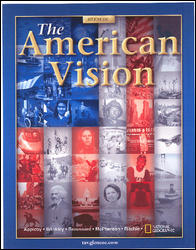The American VisionChapter 3:
Colonial Ways of Life, 1607–1763Web Lesson PlansIntroduction
Students have read about different groups in the Southern Colonies and how these groups interacted and contributed to the economic growth and lifestyle of this region. In this activity, students will take a closer look at some of the daily aspects of Southern life, centering on the first colonists to arrive in Maryland. They will learn about common issues faced by all the Southern colonists, such as farming and slavery.
Lesson Description
Students will use information from the Exploring Maryland’s Roots Web site to learn details of daily activities in the Maryland Colony. They will read about how lifestyles in this colony varied greatly, depending upon whether one was a wealthy plantation owner, an indentured servant, a poor farmer, or an enslaved person. Students will then answer four questions and apply this information by writing a report on the lifestyle of a colonist.
Instructional Objectives- Students will describe conditions of daily life in the Southern Colonies, including ways in which lifestyles varied greatly between groups and also ways in which they were similar.
- Students will be able to synthesize this knowledge into a report about one Southern colonist from the background of their choosing.
Student Web Activity Answers- When Father White’s party first sailed into the river, they found the country armed for war. The Native American Indians were ready to defend their land. They found the ground thickly covered with different kinds of nuts. There were also many vines, salad greens, herbs, and flowers.
- Growing tobacco took an amazing amount of work. Much of the year was spent clearing land and nurturing the plants. From late January to march, the farmers would grow seeds in small plots. When the seeds were about the size of a quarter, they were ready to transplant. In April and May, the farmers made hills for plants in the field. The plants were then transplanted to the hills. June, July, and August were spent weeding, thinning, and worming the tobacco. September and October were spent cutting and housing the leaves. Finally, the end of October and November were spent cramming hundreds of pounds of tobacco into casks called hogsheads.
- The Assembly met to write and change laws for the colony of Maryland. The first Assembly in Maryland was made up of two parts. The Lower House came from all freemen in the colony. Members of the Upper House were named by Lord Baltimore. Only the most important, wealthy men in Maryland were members of the Upper House.
- Enslaved African Americans became the main kind of worker in the colony of Maryland during the late 1600s.
- Students' reports will vary.
 | 






